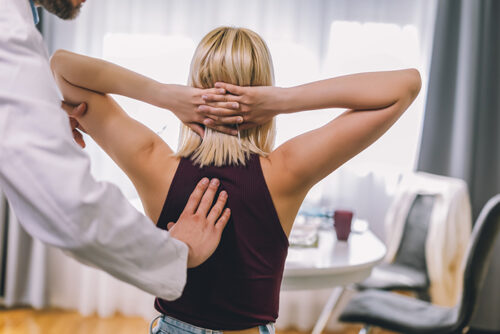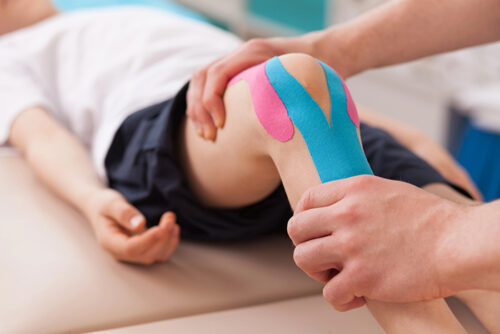LIBERTY SPORTS & PHYSICAL THERAPY
Guiding You Along The Road To Recovery
Physical therapy is a common treatment that can help you recover after an injury or surgery, or manage symptoms from a health condition that affects how you move. It’s a combination of exercises, stretches and movements that’ll increase your strength, flexibility and mobility to help you move safely and more confidently.
What Is Physical Therapy (Physiotherapy)?
Physical therapy, or physiotherapy, is a treatment that helps you improve how your body performs physical movements. It could be part of a pain management plan or specific treatment for an injury or health condition. It’s common to need physical therapy after many types of surgery, too. You might also need physical therapy to help prevent injuries before they happen.
How long you’ll need physical therapy depends on which injuries or health conditions you have and which area of your body needs help moving better. Some people only need a few weeks of physiotherapy to help with a short-term issue. Others need it for months or years to manage symptoms of a chronic (long-term) condition.
What Does Physical Therapy treat?
Most people start physical therapy after a healthcare provider diagnoses an injury or condition. Examples include:
- Sports injuries Neck pain Back pain Knee pain Hip pain Pelvic Pain Carpal Tunnel Syndrome
- Tendinopathy (tendinitis) Shoulder Pain Rotator cuff tears ACL tears or ligament injuries TMJ disorders
VIEW SHOULDER REHAB FLYER
VIEW PELVIC HEALTH FLYER
What Are The Types Of Physical Therapy?
Physical therapy is a combination of hands-on techniques (a therapist moving part of your body) and exercises or movements you perform with a physical therapist’s supervision. Physical therapy can include:
- Stretching Strength training (with or without weights or exercise equipment) Massage
- Heat or cold therapy Transcutaneous Electrical Nerve Stimulation (TENS)
It might not be easy (especially at first), but physical therapy is definitely worth it. You might feel stressed, tired or exhausted after a physical therapy session. These feelings are valid and normal. Your physical therapist will help you set realistic goals and expectations. Your strength, flexibility and mobility will improve over time. You might feel like physiotherapy isn’t working right away. But stick with it!
Special Treatments From Liberty Sport and Physical Therapy
 Overhead Athlete Program
Overhead Athlete Program
Liberty specializes in Shoulder Athlete Rehab with a focus on biomechanical analysis, performance enhancement, and injury prevention. We will help you achieve optimal results and work to optimize your peak performance! If you feel your injury is affecting your results on the field, contact us today to schedule your evaluation.
Dry Needling
A technique physical therapists use to treat pain and movement impairments. The physical therapist inserts a "dry" needle, one without medication or injection, into areas of the muscle. Dry needling is modern Western medicine and is supported by evidence-based research. It is not the same as acupuncture.
Dry needling can inactivate trigger points to relieve pain or improve range of motion. Research suggests that dry needling can also improve pain control and reduce muscle tension. Study findings also show that dry needling can help with the way our nerves interact with our muscles. This can help speed up a person’s ability to return to active rehab. Physical therapists who perform dry needling obtain additional specific education and training.
IASTM
Instrument-Assisted Soft Tissue Mobilization is a manual therapy technique that uses specially designed stainless steel instruments to break down scar tissue, adhesions, and other restrictions in the soft tissues.
- The therapist will use the instruments to apply gentle, repetitive strokes to the affected area.
- This helps to break up scar tissue and adhesions.
- The therapist may also use other techniques, such as stretching and massage, to improve range of motion and reduce pain.
- Soft tissue injuries, such as sprains, strains, and tears
- Myofascial pain syndrome
- Fibrosis
- Adhesions
- Scar tissue
Graston Technique
A type of instrument-assisted soft tissue mobilization used for injury recovery, the Graston Technique is most commonly applied by chiropractors, massage therapists, occupational therapists, osteopathic physicians and physical therapists.
How does it work?
- The Graston Technique is a manual therapy that uses stainless steel instruments to perform muscle mobilization. The tools are used in two ways:
- Practitioners move the instruments over the skin to find any muscle knots, fibrous tissue or scar tissue that can cause the patient pain or restrict movement.
- After identifying the muscle knot or tissue, practitioners use the tools to disperse it, which rehabilitates function and mobility.
To see significant results from the technique may take anywhere from six to 12 treatments. Your provider can tell you how long your treatments will last and how soon you will see improvements. It all depends on what condition you’re trying to treat, and how severe your symptoms are.
The benefits of using the Graston Technique include:
- Pain relief
- More mobility in soft tissue
- Fewer mobility restrictions in fibrous tissue
- Fewer muscle spasms
- Increased blood circulation to tissues
- Improved flexibility
 Kinesiology
Kinesiology
Kinesiology tape is a thin, flexible tape that was developed to aid muscle movement and enhance athletic performance. It is often used to relieve pain, reduce swelling and inflammation and provide support to joints and muscles. The elasticity, or stretchiness, of kinesiology tape allows for movement.
Kinesio taping is used in sports medicine, rehabilitation, and orthopedics to treat injuries, strains, and other physical issues. It can also help with pain from inflammation and lymphedema.
Cupping Therapy
An ancient form of alternative medicine where a therapist puts special cups on your skin for a few minutes to create suction. The idea is to draw blood to or away from parts of your body. People get it for many reasons, such as pain and inflammation relief, relaxation and well-being, and as a type of deep-tissue massage.
Cupping therapy is used to treat:
- Rheumatic diseases such as arthritis and fibromyalgia
- Back pain and other types of body pain
- Varicose veins
Sportsmetrics™
The first and largest ACL injury prevention program SCIENTIFICALLY PROVEN to decrease serious knee ligament injuries in female athletes. Liberty Sport and Physical Therapy offers Sportsmetrics Certified Training for their patients who need rehabilitation or athlete training.Jumping drills are used to teach the athlete to preposition the entire body safely when jumping landing.
The selection and progression of these exercises are designed for neuromuscular retraining proceeding from simple jumping drills to multi-directional, single-foot hops and plyometrics with an emphasis on quick turnover. A solid foundation of strength, coordination and overall physical conditioning is required for athletes to attain their highest potential in their sport-specific skills.
Return To Sport (RTS)
Is the process of recovering from an injury or medical condition and safely returning to a sport or physical activity. It's a comprehensive process that involves physical and psychological aspects, and often includes collaboration with a team of healthcare professionals.
Pelvic Health Services (at our Stafford Location only)
What is pelvic health PT? Pelvic health physical therapy specifically focuses on the rehabilitation of dysfunctions related to the pelvic floor muscles (which support the bladder, uterus, and rectum) aiming to improve issues like incontinence, pelvic pain, and sexual dysfunction through targeted exercises and manual therapy techniques.
-
Muscle focus:It primarily targets the pelvic floor muscles, which can become weak, tight, or have poor coordination, leading to various pelvic health problems.
-
Treatment methods:This can include exercises to strengthen or relax the pelvic floor muscles, manual therapy techniques, biofeedback to help patients learn how to properly contract and relax the muscles, and education on lifestyle modifications.
-
Conditions treated:Pelvic health physical therapy can help with conditions like urinary incontinence, fecal incontinence, pelvic organ prolapse, chronic pelvic pain, pain during intercourse, and post-partum recovery issues.
-
Specialized practitioners:Physical therapists who practice pelvic health physical therapy have undergone additional training to assess and treat pelvic floor dysfunction.
Central Virginia Orthopedic And Sports Medicine helps their patients return to their active lives stronger and without pain. We consistently, expertly, and compassionately provide optimal medical care to adults, children, athletes of all levels, as well as professionals to allow them to live healthy, happy, and purposeful lives. Make an appointment today so we can guide you along the road to recovery!

